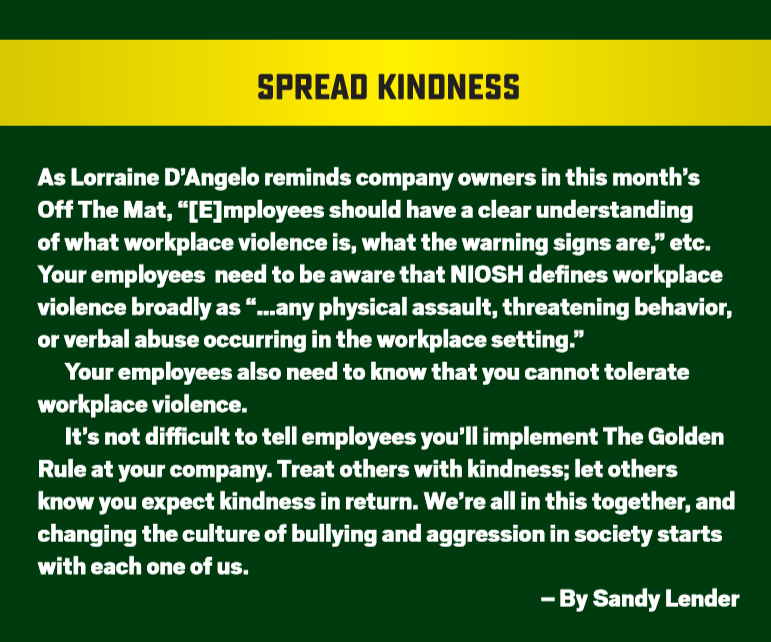You Can Prevent Worksite Violence
BY Lorraine D'Angelo

Each year, according to the Occupational Safety and Health Administration (OSHA), more than 2 million workers become victims of workplace violence. The Bureau of Labor Statistics reports that 8.6 percent of the 4,836 workplace fatalities were homicides. Although construction sites are not the most common place that such violence takes place, the number of incidents occurring on worksites is still too high. Workplace violence is an issue that all employers must address.
Workplace violence is defined by the National Institute for Occupational Safety and Health (NIOSH) as “…any physical assault, threatening behavior, or verbal abuse occurring in the workplace setting.”
The Federal Bureau of Investigation (FBI) has identified four different categories of workplace violence:
- violent acts by criminals who have no connection with the workplace except to enter it to commit a crime;
- violence directed at employees by customers, clients, or others for whom the organization provides services;
- violence against co-workers, supervisors, or managers by a present or former employee; and
- violence committed by someone that does not work there but has a personal relationship with an employee.
Source: U.S. Department of Justice, Federal Bureau of Investigation
Workplace violence is both the actual violent act and threats of violence. It encompasses a range of acts including physical violence, homicide, intimidation, rape, harassment, profanity, threats, obscene phone calls, following or shouting at someone, or any other disruptive or potentially dangerous behavior. Under the general duty clause of the OSHA regulations, an employer is required to provide its employees with a safe workplace without recognized hazards that are likely to cause serious harm or death. Failure of an employer to address or minimize the risk of workplace violence can make an employer liable, and subject it to lawsuits, fines and other monetary penalties. Employers also suffer other losses such as employee turnover and loss of productivity.
An employer should assess its workspaces and address the risks that are identified by the assessment. As an employer you should take precautions to prevent or minimize the risk of workplace violence. Some steps you can take include:
- Create a written policy clearly identifying the prohibited behavior and establishing procedures to follow should violence occur;
- Communicate and train on the policy so all employees know what to do if they are the target or a witness to workplace violence;
- Hold practice drills and establish crisis procedures for response to an incident;
- Identify the reporting process and/or provide an anonymous hotline/helpline for reporting;
- Secure your worksite or office and monitor those who visit the workplace site; and
- Monitor your worksites and office locations to assess culture and civility.

One of the most important actions an employer can take is to assure any employee who does raise his or her hand that the organization will support and protect the employee from harassment, retaliation and intimidation. Many employees do not report workplace violence due to fear: fear of retaliation to themselves or to their family or co-workers, fear of becoming the “snitch,” fear of being embroiled in a legal proceeding or grievance, or fear of their supervisor’s reaction.
These fears can be overcome by identifying the problematic behavior, creating clear reporting guidelines, holding supervisors accountable and providing training that communicates how workplace violence threatens safety in the workplace.
Denial or acceptance of such behavior (statements such as, “Joe is just being Joe”) also have to be addressed. Employees must be able to trust that when they do report, the company will take the appropriate steps to eradicate the bad behavior.
Employees should have a clear understanding of what workplace violence is, what the warning signs are, how they should handle the situation and where they should go to report a potentially violent situation.

Lorraine D’Angelo
Lorraine D’Angelo, a nationally recognized expert on legal and regulatory risk management, is the president of LDA Compliance Consulting Inc. She has more than 25 years of experience in the construction industry, including a recent tenure as senior vice president for ethics and compliance at a global construction company. D’Angelo is an accredited ethics and compliance professional and a leading expert on small, women-owned, minority and DBE matters, programs and policy implementation. For more information, contact her office at (914) 548-6369 or Lorraine@ldacomplianceconsulting.com.
